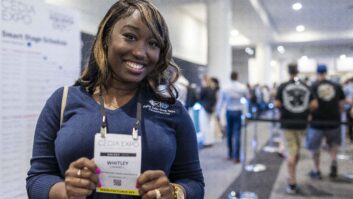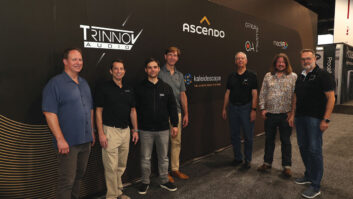There was so much to see at CEDIA this year that it took a bit of time post-show to gather my thoughts. While this year’s show didn’t have any one overarching theme like voice which dominated last year’s event, there was still plenty to get excited about, and after some reflection, here are my observations on trends and standouts at the show that will likely affect our industry in the upcoming year.

Crowds gathered for CEDIA 2017
The Show
San Diego was an absolute homerun as a host city, with tons of hotels and restaurants easily able to accommodate everyone, and the city itself had a very pedestrian-friendly layout that made getting around a breeze. If CEDIA decided to alternate between San Diego and Denver, they would certainly get no complaints from this attendee (although word has it that SD is expensive for exhibitors.)
The general vibe at the show was really upbeat and positive, and not all of that can be attributed to the dreamy San Diego weather, ocean-front location, and inspired local craft beer scene. Attendees and manufacturers alike all seemed to be in high spirits, with solid traffic for nearly all exhibitors, and mobs of people at the “tent pole” booths like Sony, Samsung, SnapAV, and Control4. The continued recovery of the housing market certainly appears to be doing this industry well, across all segments of the CI market, and people seemed genuinely excited to be at CEDIA, checking out ways to drive their business forward.
Projection

Epson’s LS100 Ultra Short Throw Projector One of the starkest differences between CEDIA and CES is the focus on projection. While one may find a couple of projection demos at CES, they abounded at CEDIA and were the video display device of choice in every demo I sat through. This clearly speaks to the ongoing importance home theater and large screen displays play in our market, and certainly remains one of the largest differentiators between the CI channel and a Big Box installer.
However, you can see the “media room” concept — where an entertainment system is installed in a non-dedicated space — really continuing to take hold with every screen manufacturer touting high ambient light rejecting screens, or screen designs that are more décor friendly.
Ultra-short-throw projectors that can be placed in cabinetry or discreetly on the floor and deliver a 100-plus-inch image while taking up virtually zero space in the room continue to become popular solutions. Models were on display from Sony, Epson, Vivotek, Hisense, and more.
Finally, using a laser light source continues to gain traction. Laser offers the potential benefits of longer life, faster start-up times, higher contrast ratios, great light output, and wider color gamuts, and the price for laser projection continues to drop.
4K

Sony’s VPL-VW285ES 4K Projector
By far, the biggest news on the projection front for me was Sony’s announcement of a sub-$5,000, true 4K (4096 x 2160) projector, the VPL-VW285ES. I think this will help drive 4K projection sales in the mid-market, and will likely lead to a lot of upgrade purchases by people that have been hanging on to an older 1080p model and were on the fence about upgrading due to the previous high price of 4K entry. Our company immediately ordered — and sold — two of them on Day 1 of CEDIA. Sony also debuted a new $25,000 laser 4K model — cutting the price in half compared to its previous laser 4K offering — and the image looked fantastic on the 165-inch diagonal screen used for the demonstration.
Other manufacturers— JVC, Epson, Optoma — showed new models but are still relying on pixel-shifting technologies to get all the pixels on the screen, instead of using a native 4K chip. While the results can be impressive — and the pricing very competitive — this remains an area where Sony continues to differentiate itself. Whether it is important and resonates with customers we shall have to wait and see.
Multi-Channel Audio
Dolby Atmos is now a de facto technology, and 7.1.4 systems were commonplace for demos at CEDIA. What seems to really differentiate the mass-market from the truly high-end are channel counts. Every consumer processor — Denon, Marantz, Onkyo, Pioneer, Yamaha, Sony — still maxes out at “only” 11 channels of processing power. While this is enough to cover most rooms, for large, dedicated media rooms that need more speakers for better immersion at every seat, 7.1.4 no longer cuts it.
Emotiva showed a nearly finished version of its new RMC-1 AV processor, which will be capable of 9.1.6 systems when it ships. Datasat and Storm Audio also have higher channel count solutions available.
But the king of the high-channel count market remains Trinnov, with the company’s Altitude 32 being used in numerous demos throughout at the show.
Surprising to me is the continued slow roll-out of DTS:X content. “When will you support DTS:X?” was a common question at past shows as manufacturers needed firmware patches to add support, but it seems to have been a non-issue as there still remains little content. In fact I heard just a single DTS:X demo at the show at the Marantz demo theater, and rarely heard it mentioned elsewhere. Auro-3D was given brief time in the JBL Synthesis demo, using the Auromatic upmixer to raise a DTS-HD 7.1-channel track to fill the room’s 30 channels, but it also continues to have difficulty gaining a foothold here in the States. However, on the Auro front, Denon and Marantz will be including Auro-3D at no additional charge in higher end models in this year’s line-up. (Previously Auro-3D had required an optional $199 upgrade.)
Room Correction
Another technology that seems to be really gaining traction in the CI space is Dirac’s room correction. I heard more company’s touting Dirac this year than at any I can recall in the past. Previously, Dirac was only available at the upper end of the market, found in products like Datasat, Wisdom, and Theta Digital, but the company appears to be licensing its technology to a growing list of manufacturers at all price points. I know that Dirac is a preferred solution for fellow Resi reviewer, Dennis Burger, which he feels offers more power and control over competing solutions as to how you correct a room, while still letting your speakers sound like your speakers. According to Burger, Dirac lets you make intelligent and informed decisions about the room correction being performed and what is happening in your room, giving users a myriad of information to deliver the best results possible. “Dirac rewards patience,” Burger told me. “And it rewards knowledge and understanding.”
Cat and Fiber

The Starke Sound and FIBBR teams crowding together for a shot in the Show Daily. You can encounter a lot of issues running a traditional HDMI cable more than about 5-6 meters and expecting reliable results when displaying Ultra HD content, especially with something like Billy Lynn’s Long Halftime Walk, which pushes the full 18Gbps boundary at 4k60. Accordingly there were a lot of companies displaying HDMI-over-Category solutions, with products promising full 18Gbps support up to hundreds of fee. One solution that really caught my eye was from FIBBR, with a discrepancy at the press event about how it is pronounced whether “fiber” or “fibber.” Tomayto, tomahto, whatever, what FIBBR does is embed a robust fiber optic cable — they challenged people to come by the booth and try to break it — in a package terminated with traditional HDMI ends. This encode/decode from HDMI to fiber and back is all performed by a chip inside the HDMI head shell. And any issues we have now with signal transmission will seem like child’s play when HDMI 2.1 comes out, with 48Gbps bandwidth written into the spec. To show the company is ready for this future, FIBBR showed a preview of the world’s first 56Gbps 8K-HDR capable cable…in a 50-meter length!
Demo Material
I always wonder what will be the go-to demo scene used at the show, and there was no clear favorite this year. With all of the terrific looking and sounding 4K content out there, it seemed like it would be easy to choose compelling material, but many manufacturers relied on the latest Dolby Atmos demonstration disc , with the opening scene from Unbroken and the Wildfire boat attack from “Game of Thrones” both getting a lot of play. And at least one manufacturer was still using “Bailando,” making me ask, “Por que? AY, DIOS MIO, POR QUE?!?” The movie that got the most demo time was Guardians of the Galaxy Vol. 2, with at least three different manufacturers using it. Also prevalent was Kaleidescape’s Strato 4K movie player, being the go-to demo source in many booths.
The three most sonically impressive demos for me were found at JBL Synthesis, Phase Technology dARTS, and Pro Audio Technology booths. JBL showed off its Trinnov-based processor driving nearly 30-discrete channels for an incredibly immersive experience that certainly rivaled any commercial cinema. The system sounded effortless, producing high SPLs that were incredibly easy to listen to, and incredibly even bass. Also, JBL selected terrific demo material including, Guardians of the Galaxy Vol. 2 and Passengers, letting the scenes run a bit long to really create great drama. The dARTS demo was notable for its localization, with the “Leaf” demo from the Atmos disc revealing subtle sonic cues and object tracking that was really stunning, which is saying something since I think I’ve sat through that clip like 100 times. Pro Audio Technology pulled out an oldie-but-goodie with the rocket launch from Apollo 13, with the system producing massive bass that literally pounded you in the chest and shook you in your seat. It was exhilarating, pulse quickening, and really a testament to what a well-designed 5.2-channel audio system could accomplish. Their demo was capable of producing such mind-rattling SPL levels that they company backed the demo off by about 7.5 dB, however it still had incredible dynamics and impact, and all this from the company’s least expensive speaker package!







